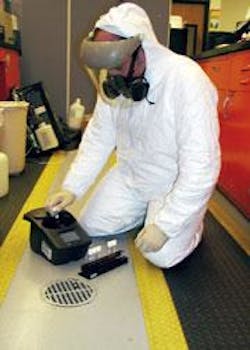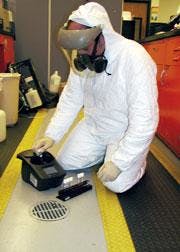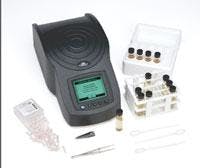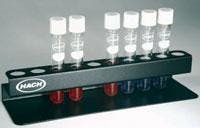Toxicity Testing Emerging in Water System Management
While water utilities in the U.S. and the regulatory agencies working with them achieve and maintain continuously higher water treatment standards, they recognize the challenge left unmet: to effectively monitor and manage the quality of finished water from these well-tuned treatment plants, throughout the remote storage and distribution system.
Because system intrusion – accidental or intentional – could introduce a veritable supermarket of adulterants, experts promote measurement of indicator parameters such as chlorine, pH, and toxicity as a practical means of detecting and mitigating network water quality upsets.
Toxicity Testing
The toxicity assay is capable of detecting a diversity of analytes – solvents, herbicides and pesticides, heavy metals, PCBs and other industrial chemicals – in a single test, making it a powerful screening tool. (It's important to note that a toxicity assay detects the effect of the toxic substance on the bacteria but does not specifically identify the substance or its concentration.)
Toxicity assays have long been applied by the water utility operator's counterpart at the sewage treatment plant. There, routine toxicity assays using the facility's indigenous bacteria make certain treatment plant influent does not contain substances harmful to the microorganisms responsible for biological processing of waste.
Water utilities monitoring their influent for watershed contamination and the impact of river spills, agricultural runoff of triazines and other applied chemicals, or other contamination possibilities, also are familiar with toxicity assessment. In this application, the Daphnia toximeter – while costly at better than $40,000 per unit – provides a continuous screen of the plant influent.
More recently, municipal fire departments, emergency first responders and distribution system engineers have added the toxicity test to their toolboxes. Some water systems currently use packaged toxicity tests within the distribution network to help confirm an alert from an independent, continuous-monitoring system. In such a case, the on-site toxicity assay serves as a first-line investigation tool that can help minimize false positives, or verify the need for emergency response.
New Toxicity Tests
As many water utilities face increasing potential of undetected influence due to corrosion and frequent repair and maintenance of their aging network infrastructures, the on-site toxicity assay becomes a more valuable tool in detecting water quality compromise. Different tests are available, each differing in cost and ease of use.
Luminescence toxicity tests measure the effect of toxins on the light output of specific, luminescent bacteria. Methods relying on ß-galactosidase activity (cleaving of the fluorescent dye ONPG) rely on a genetically engineered strain of Escherichia coli, or the Daphnia organism. Oxygen consumption methods provide a good measure of overall bacterial health; however, they require at least a 30-minute aeration process and extensive sample handling and measurement with a dissolved oxygen (DO) meter that can result in the loss of volatile toxins.
The newer ToxTrak™ Toxicity Test from Hach Co. makes use of resazurin, a redox-active dye. This dye, in the oxidized state at the beginning of the test, is blue; bacteria oxidize the glucose added to the sample with the dye and reduce the resazurin to resorufin, which is pink-colored. Simply, substances that are toxic to bacteria can inhibit their metabolism and the extent of resazurin reduction and color change.
The ToxTrack Test also makes use of a patented gluteraldehyde accelerant that significantly reduces reaction time, compared to that of other toxicity assays. The accelerated test suffers less from oxygen interference and allows the use of a smaller inoculum of bacteria. As a result, the sample does not require centrifugation or extraction to remove bacterial cells prior to measurement visually or in a general-purpose colorimeter or spectrophotometer. Several samples from different sources can be tested concurrently. Operators read color change in about 45 minutes, at a cost of about $2 per test.
Based on primary bacterial metabolism, the resazurin reduction toxicity assay can be used with a wide variety of gram-positive and gram-negative bacteria, making it the preferred method for wastewater processes assessing toxicity to their indigenous bacterial cultures. This feature also makes the test economical for any user.
Water System Benefits
As with any toxicity test using surrogate organisms, the ToxTrak Test is not all-inclusive. Yet, critical evaluation shows it detects change in bacterial metabolism caused by a wide variety of potential distribution system contaminants, including heavy metals arsenic, cadmium, lead, mercury, and thallium; herbicides alachlor, cacodylic acid, cyanazine, diquat, endothal, glyphosate, and paraquat; insecticides dichlorvos, lindane, malathion, parathion, and others; nematocides and rodenticides bromadiolon, fenamiphos, sodium fluoroacetate, oxamyl, and strychnine; industrial chemicals cyanide, fluoride, sodium diethyl dithiocarbamate (NaDDTC), and PCB (arochlor 1248); low level radioactive salts of uranium and thorium; commercial products such as bug sprays and lawn chemicals, and even chemical warfare agents ß-aflatoxin and ethoprophos (tested as a surrogate for VX nerve agent).
So how would the water utility benefit with streamlined, on-site detection of these substances? Situations requiring an emergency assay response are fortunately few, but frightening. Transient low, or negative, pressure caused by main breaks, flushing, pump failure, or emergency firefighting water drawdown can result in backflow, or backsiphoning. Backpressure through a cross-connection, caused by heating or cooling, waste disposal, or industrial manufacturing systems connected to potable water supplies, can introduce potentially contaminated water from industrial, commercial, or residential sites via the reversed flow of water.
The proactive utility will establish a toxicity baseline of its source water or key points in the distribution network to identify normal daily and seasonal variations. The utility could read subsequent assays against this baseline when water integrity is questioned. An economical toxicity test lets system personnel verify suspected system incursions immediately and map the extent and duration of contaminant plume.
Further, water security experts recommend toxicity testing to complement a continuous monitoring system that signals sudden changes in water profile and provides real-time data and alert to plant operators or SCADA systems. Such an automated system can trigger autosamplers that collect a discrete sample, without possible contaminant exposure to operators, for immediate toxicity assessment.
The on-site toxicity test also empowers a utility to respond to malevolent contamination – that from sabotage, vandalism, or terrorism. The reliable and prompt assay could provide enormous benefit if just by identifying hoaxes.
Finally, for utilities sharing personnel and equipment for both water and wastewater treatment operations, a universal toxicity test such as the resazurin reduction test can serve multiple purposes: assessing overall influent toxicity to the sludge treatment system; streamlining and saving cost and effort for Whole Effluent Toxicity (WET) tests, Toxicity Reduction Evaluations (TREs), and Toxicity Identification Evaluations (TIEs); and enabling water-side personnel to assess distribution system health frequently.



